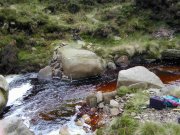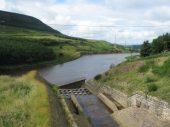Why is Water Important?

- Water has many uses, think about how much water you use everyday and how much is used to make things like bottles of Coke and the electric that you're using to run this computer...
- The quality of water is of great importance in determining the uses to which the water can be put.
- The increasing demand for unlimited water supply in many different applications (agriculture, industry, domestic etc.) linked to the ever increasing sources of pollution (both in pollution amount and type) means there is a greater potential for environmental damage to water courses than ever before.
Water in the Dark Peak

- The upland catchment areas of the Peak District were seen in the 1800's as a cheap, reliable and clean source of water, ideal to serve the needs of the growing industrial cities surrounding it.
- No large natural lakes exist in the Peaks, but the high annual rainfall and shale valleys (which are impermeable) make the area suitable for water gathering.
- Reservoirs were built throughout the Peaks from the 1850's
- The series of 6 reservoirs along the River Etherow, through Longdendale are one of North West Water's (now United Utilities) largest water sources.
- The reservoirs provide an average of 102 Million litres of drinking water for the people of Manchester and Stockport.
Rain in the Dark Peak
- It rains 2 out of 3 days in the Dark Peak.
- This amounts to approximately 2000mm rainfall per year.
- Values are even higher on the summits of Bleaklow and Kinderscout.
Problems caused by high rainfall
- Surface run-off from the surrounding peat covered catchment have the potential to transport high levels of sediments into the reservoirs.
- This threatens the water supply they contain by silting up the reservoir and discolouring the water.
- Peat solutes cause discolouration of the water in autumn and winter after relatively dry summers.
- Agricultural fertilisers and pesticides contain nitrates, heavy metals etc. which are potential sources of pollution when washed into the water sources.
- Heavy metals, originally from atmospheric pollution, can also be released from highly humified (decomposed) peat.
- Climate change may also effect rainfall, and therefore run-off patterns.
- Floods and droughts may become more common in the Dark Peak.
- Recent drought events in the Dark Peak resulted from prolonged winter rainfall (winter 2000/2001) and, Intense summer storms (July 2002).
We will now consider more specifically the hydrology of blanket peat
